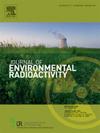Monitoring the changing levels of radon emanation from former uranium mine dumps in different seasons and their effect on the surrounding atmosphere
IF 1.9
3区 环境科学与生态学
Q3 ENVIRONMENTAL SCIENCES
引用次数: 0
Abstract
Uranium mining waste represents a considerable potential source of radon emissions in the nearby environment. The project's aim (2021–2024) was to observe and evaluate the effects of seasonal fluctuations in radon release from former uranium mine dumps No.15 and No.4 in the Příbram area and their influence on the surrounding atmosphere. The objective was to describe the radiation situation and homogeneity of the dumps and to record and analyze the impact of climatic conditions, which contribute to radon transport to the adjacent communities. The progressive phase involved aerial and field measurements of the Ambient Dose Equivalent Rate, detecting hot spots using an unmanned aerial vehicle (UAV), collecting air samples with Lukas cells, and continuously monitoring Radon Activity Concentration. Meteorological data filtered for conditions of temperatures, absence of wind, and no precipitation during night-time hours (from 8:00 p.m. to 6:00 a.m.) identified 890 days between 2005 and 2023. This corresponds to an average of 47 days per year during which conditions conducive to radon transport to the vicinity of the dumps were present, which, as determined, influences radon activity concentrations and their subsequent dispersion into the surrounding environment. These measurements confirmed elevated radon activity concentrations in the ambient air, exceeding several kBq/m³ with measured maxima of 27 kBq/m³. This project's integration of monitoring methods has resulted in a novel, comprehensive approach to determining radon transport from the dump to nearby communities. The ability to accurately identify areas with elevated Radon Activity Concentrations (RAC) plays a crucial role in optimizing strategies to mitigate the impact of radon decay products on public health.
监测原铀矿堆放场不同季节氡排放水平的变化及其对周围大气的影响
铀矿开采废料是附近环境中氡排放的一个相当大的潜在来源。该项目的目标(2021-2024年)是观察和评估Příbram地区15号和4号原铀矿堆氡释放季节性波动的影响及其对周围大气的影响。目的是描述垃圾场的辐射情况和均匀性,并记录和分析气候条件的影响,因为气候条件有助于氡向邻近社区输送。进展阶段包括空中和现场测量环境剂量当量率,使用无人驾驶飞行器(UAV)探测热点,用卢卡斯细胞收集空气样本,并持续监测氡活性浓度。在2005年至2023年期间,经气象资料过滤后的气温、无风及夜间(由晚上8时至早上6时)无降水情况共890天。这相当于每年平均有47天存在有利于氡迁移到垃圾场附近的条件,经确定,这些条件会影响氡活度浓度及其随后向周围环境的扩散。这些测量结果证实,周围空气中的氡活度浓度升高,超过了几kBq/m³,测量到的最大值为27 kBq/m³。该项目综合了各种监测方法,形成了一种新的、全面的方法来确定氡从垃圾场向附近社区的运输情况。准确识别氡活性浓度升高地区的能力在优化战略以减轻氡衰变产物对公众健康的影响方面起着至关重要的作用。
本文章由计算机程序翻译,如有差异,请以英文原文为准。
求助全文
约1分钟内获得全文
求助全文
来源期刊

Journal of environmental radioactivity
环境科学-环境科学
CiteScore
4.70
自引率
13.00%
发文量
209
审稿时长
73 days
期刊介绍:
The Journal of Environmental Radioactivity provides a coherent international forum for publication of original research or review papers on any aspect of the occurrence of radioactivity in natural systems.
Relevant subject areas range from applications of environmental radionuclides as mechanistic or timescale tracers of natural processes to assessments of the radioecological or radiological effects of ambient radioactivity. Papers deal with naturally occurring nuclides or with those created and released by man through nuclear weapons manufacture and testing, energy production, fuel-cycle technology, etc. Reports on radioactivity in the oceans, sediments, rivers, lakes, groundwaters, soils, atmosphere and all divisions of the biosphere are welcomed, but these should not simply be of a monitoring nature unless the data are particularly innovative.
 求助内容:
求助内容: 应助结果提醒方式:
应助结果提醒方式:


